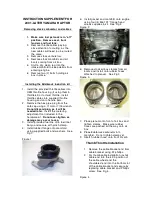
WARNING:
When possible, all children 12 years old and under
should be properly restrained in a rear seating position. Failure
to follow this could seriously increase the risk of injury or death.
WARNING:
Safety belts and seats can become hot in a vehicle
that has been closed up in sunny weather; they could burn a
small child. Check seat covers and buckles before you place a child
anywhere near them.
WARNING:
Front and rear seat occupants, including pregnant
women, should wear safety belts for optimum protection in an
accident.
All seating positions in this vehicle have lap and shoulder safety belts. All
occupants of the vehicle should always properly wear their safety belts,
even when an airbag supplemental restraint system is provided.
The safety belt system consists of:
•
Lap and shoulder safety belts.
•
Shoulder safety belt with automatic locking mode (except driver and
rear inflatable safety belt).
•
Height adjuster at the front outboard seating positions.
•
Safety belt pretensioner at the front outboard seating positions.
•
Belt tension sensor at the front outboard passenger seating position.
•
Safety belt warning light and chime. See
Safety Belt
Warning Light and Indicator Chime
later in this chapter.
•
Crash sensors and monitoring system with readiness
indicator. See
Crash Sensors and Airbag Indicator
in the
Supplemental Restraint System
chapter.
The safety belt pretensioners and rear inflatable safety belts are designed
to activate in frontal, near-frontal and side crashes, and in rollovers. The
safety belt pretensioners at the front seating positions are designed to
tighten the safety belts firmly against the occupant’s body when
activated. This helps increase the effectiveness of the safety belts. In
frontal crashes, the safety belt pretensioners can be activated alone or, if
the crash is of sufficient severity, together with the front airbags.
38
Safety Belts
2015 MKT
(mkt)
Owners Guide gf, 1st Printing, October 2014
USA
(fus)
















































